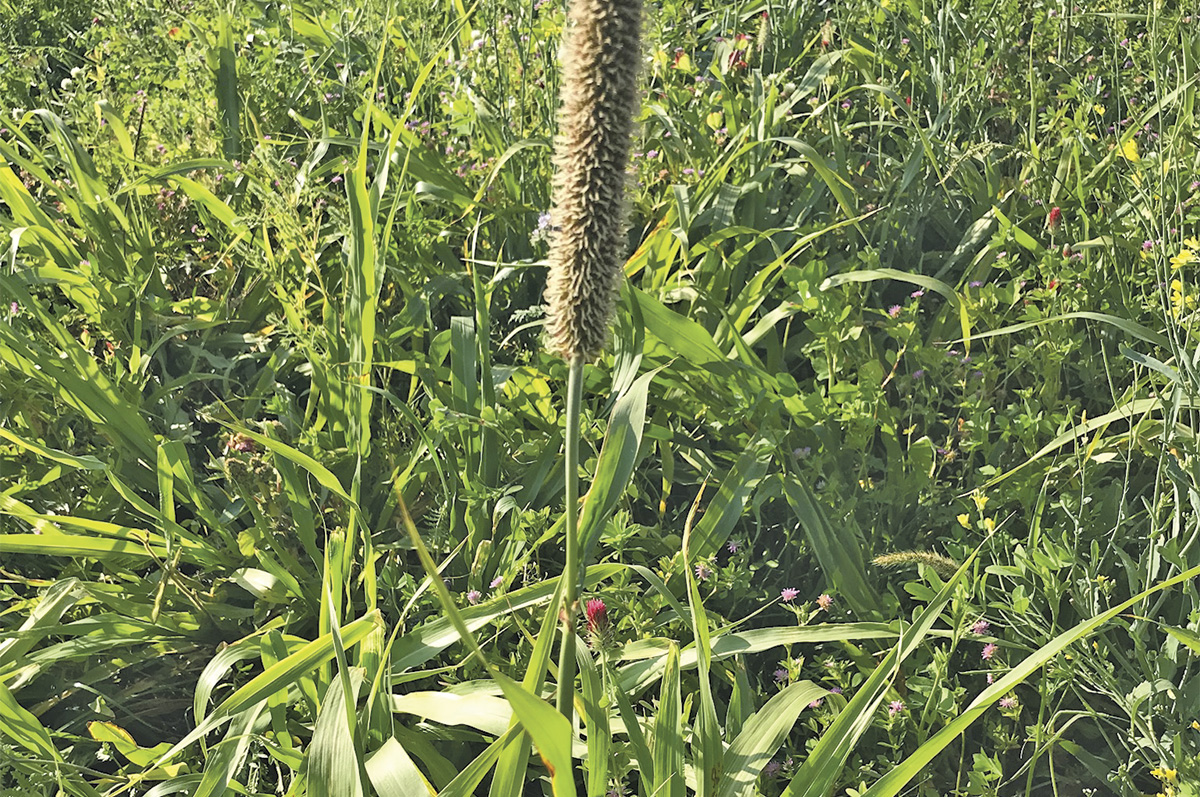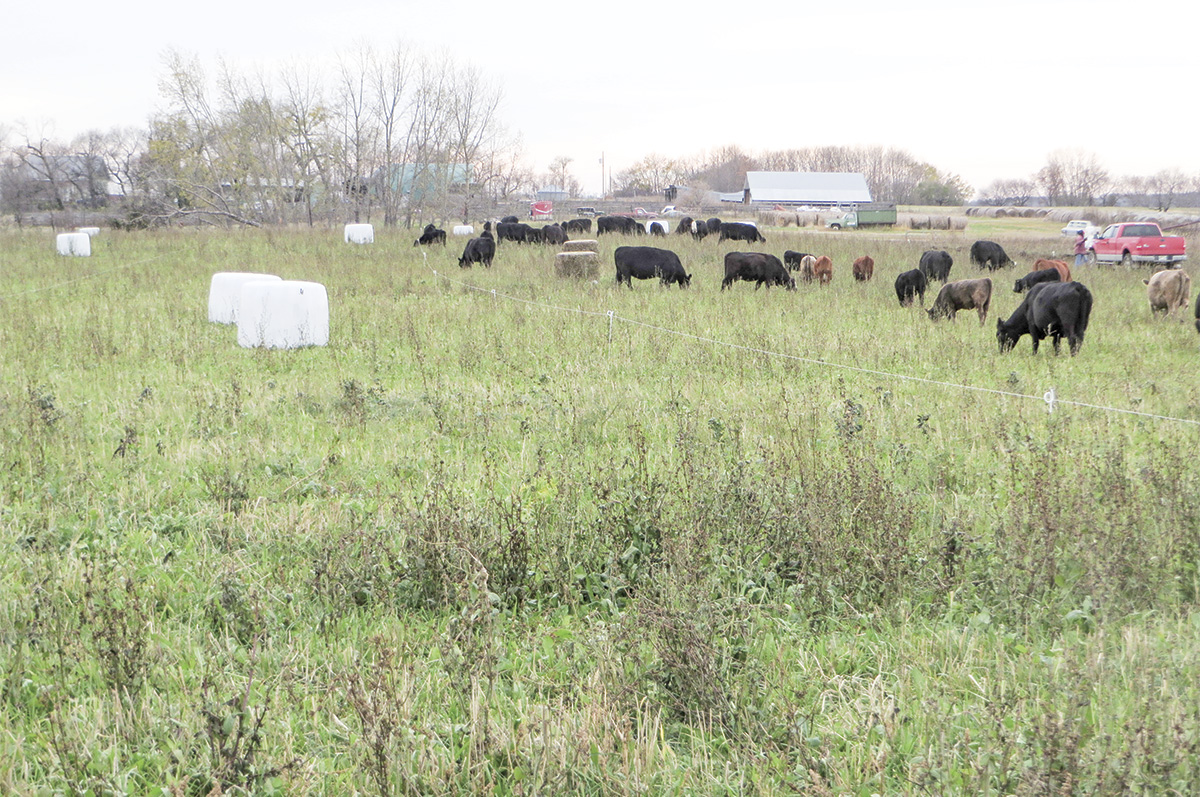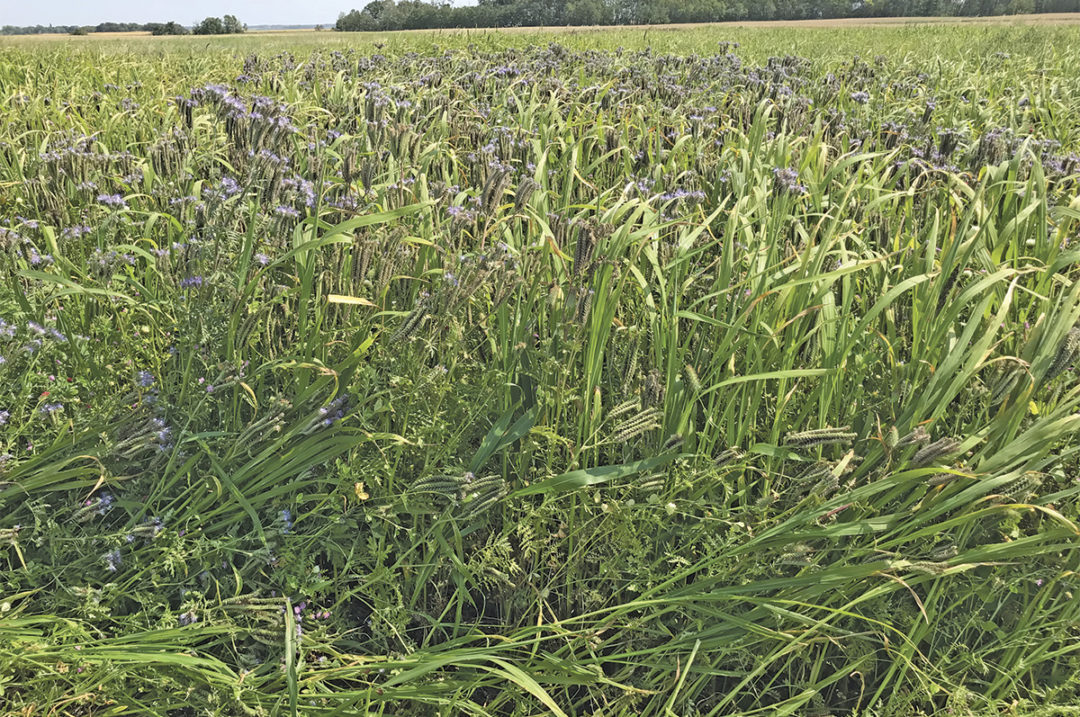Producers who have crops and livestock are finding that annual crops can fill some grazing gaps and help get the soil in better health before replanting a pasture or the next crop. Kevin Elmy (Friendly Acres Seed Farm in Saskatchewan) often gives presentations for producers regarding various ways to improve pasture production.
When and what to plant
Some forages that in the past were considered “cover crops” between traditional crops (to keep the ground covered and prevent erosion and add fertility to the soil) today are often planted for grazing.
The best balance in a cover crop is a mix of grasses, legumes and broadleaf plants. “A good cover crop contains all three. A great cover crop includes a warm-season grass, cool-season grass, warm-season legume, cool-season legume, warm-season broadleaf and cool-season broadleaf. Diversity is the key,” says Elmy. He suggests using a triangle to visualize this balance, using these three plant groups, to determine how to put together these blends. The grasses should make up the base of the triangle (the majority of the plants), then the legumes and a smaller amount of broadleaf plants.
“When seeding early, while there is still a chance for frost, warm-season plants won’t do well. It’s better to get some cool-season plants growing, such as oats, barley, peas, cool-season grasses, and maybe chicory or plantain. Grasses will produce the most pounds per acre of forage, and legumes add nutrient quality for livestock and nitrogen-fixing for the soil,” he says.
“Broadleaf plants like brassicas should just be a small part of the mix because they are non-mycorrhizal.” Mycorrhizal fungi have symbiotic relationships with plants. The fungi colonize the root system of a host plant and provide increased water and nutrient absorption capabilities. The plant provides the fungus with carbohydrates created through photosynthesis, in a mutually beneficial relationship. Some plants, like brassicas, are resistant to mycorrhizal fungi and remain uncolonized by fungi.

A cover crop mix contains a mix of grasses, legumes and broadleaf plants. Photo by Kevin Elmy.
We need to adjust the mix to have fewer brassicas and more grass, especially energy-dense grasses. “Another thing we can do is add a winter cereal because these species keep regrowing through the year and facilitate rotational grazing,” says Elmy.
“If you are planning to break up an old pasture or hay stand that is old and tired, the carbon-to-nitrogen ratio in that soil is probably out of balance, and you need more nitrogen, transitioning back into production with a blend that contains a high level of legumes – to add nitrogen – along with the grasses. The next year, you can cut back on the amount of legumes in that seeding and increase the amount of grasses, and introduce a broadleaf into the mix. By year three you have a lot more options because your productivity is back again,” he says.
To rejuvenate tired fields, you also want to get more sugar back into the soil, to wake up the soil biology. This results in healthier soil and more forage. “As soon as you get the soil biology back into balance, everything else falls into place,” says Elmy.
Rejuvenating the soil
Jay Fuhrer gave a presentation at an organic meeting in Saskatoon a few years ago, and one of the things he talked about is how important this balance is. “He told a story about a family farm and said Grandpa was a great farmer. He could throw any kind of seed at the ground and get a bumper crop. The dad was also a good farmer, but not quite as good as Grandpa, but he got good crops. The son, however, was struggling to make it work. Fuhrer explained that it all goes back to carbon in the soil. Grandpa had high carbon, the dad had medium carbon but by the next generation, it was dwindling,” Elmy explains.
In Ohio, researchers estimate that about 50% of the carbon in the soil is gone – compared to what it was prior to breaking it up for farming. “David Montgomery, a geologist from University of Washington, talks about loss of carbon. He wrote a book called Dirt: The Erosion of Civilizations and said that every civilization that flourished and then collapsed failed because soils were no longer fertile,” says Elmy.

One strategy is to never graze perennial forages in August, September and October because that’s when those plants are trying to prepare for overwintering. Photo by Clayton Robbins.
One of the interesting ones is the Persian Empire – an early civilization in the Fertile Crescent in the Middle East. Mesopotamia, the portion of the Fertile Crescent between the Tigris and Euphrates Rivers, was where several early civilizations sprang up, thanks to fertile soil and irrigation from the rivers. Agriculture blossomed, enabling civilizations to grow in size and complexity. This area is now Iraq and Iran and is mainly desert due to the way those early farmers mismanaged the soil.
“The Aztec civilization in Central America did the same thing. It also happened in Greece and Rome. In North America, we are currently in the same process, creating bacterial-based soils, which are addicted to inputs,” says Elmy.
“Stockmen need to change perspective. We are not cattle producers – we are grass managers.” We grow grass to feed our cattle, and cattle are our best tools for managing the grass and for solving the problems of overcropping.
“Some of the feed tests Jay Fuhrer has taken from the top half of a plant versus the bottom half show that the top half has superior feed values. If your animals are taking just the top half (the best nutrients) and leaving half to enable the plant to recover, you will have better feed quality, more production from the livestock and the pasture – and the farm,” says Elmy.
One strategy is to never graze perennial forages in August, September and October because that’s when those plants are trying to prepare for overwintering. “This is where annual crops come into the picture, to fill that gap. They are not going to overwinter and you can graze those acres hard,” he says.
The challenge for many livestock producers is that they don’t grow crops. This is when it’s great for them to partner with a neighbor who farms. Many farmers don’t own cows and don’t want to own cows, but livestock can benefit their land – coming in to graze at the right time to help improve soil fertility.
“The farmer doesn’t need to learn how to raise or manage animals, but [he] knows how to grow things. The cattle producer knows how to manage cattle but doesn’t know how to seed and harvest. Partnering can be a win-win situation for farmers who want to diversify [their] cropping system, reduce the chemical load on their land and reduce fertilizer needs,” he explains. When you bring cattle in, it solves many issues of modern agriculture. Cattle do the trampling and leave litter and natural fertilizer, which is much better than chemicals. By having cattle on the land at the proper time, inputs for growing crops are greatly reduced.










